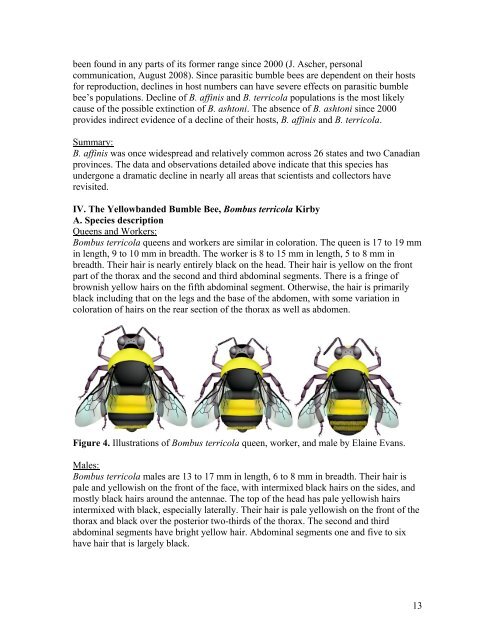Status Review of Three Formerly Common Species of Bumble Bee ...
Status Review of Three Formerly Common Species of Bumble Bee ...
Status Review of Three Formerly Common Species of Bumble Bee ...
You also want an ePaper? Increase the reach of your titles
YUMPU automatically turns print PDFs into web optimized ePapers that Google loves.
een found in any parts <strong>of</strong> its former range since 2000 (J. Ascher, personalcommunication, August 2008). Since parasitic bumble bees are dependent on their hostsfor reproduction, declines in host numbers can have severe effects on parasitic bumblebee’s populations. Decline <strong>of</strong> B. affinis and B. terricola populations is the most likelycause <strong>of</strong> the possible extinction <strong>of</strong> B. ashtoni. The absence <strong>of</strong> B. ashtoni since 2000provides indirect evidence <strong>of</strong> a decline <strong>of</strong> their hosts, B. affinis and B. terricola.Summary:B. affinis was once widespread and relatively common across 26 states and two Canadianprovinces. The data and observations detailed above indicate that this species hasundergone a dramatic decline in nearly all areas that scientists and collectors haverevisited.IV. The Yellowbanded <strong>Bumble</strong> <strong>Bee</strong>, Bombus terricola KirbyA. <strong>Species</strong> descriptionQueens and Workers:Bombus terricola queens and workers are similar in coloration. The queen is 17 to 19 mmin length, 9 to 10 mm in breadth. The worker is 8 to 15 mm in length, 5 to 8 mm inbreadth. Their hair is nearly entirely black on the head. Their hair is yellow on the frontpart <strong>of</strong> the thorax and the second and third abdominal segments. There is a fringe <strong>of</strong>brownish yellow hairs on the fifth abdominal segment. Otherwise, the hair is primarilyblack including that on the legs and the base <strong>of</strong> the abdomen, with some variation incoloration <strong>of</strong> hairs on the rear section <strong>of</strong> the thorax as well as abdomen.Figure 4. Illustrations <strong>of</strong> Bombus terricola queen, worker, and male by Elaine Evans.Males:Bombus terricola males are 13 to 17 mm in length, 6 to 8 mm in breadth. Their hair ispale and yellowish on the front <strong>of</strong> the face, with intermixed black hairs on the sides, andmostly black hairs around the antennae. The top <strong>of</strong> the head has pale yellowish hairsintermixed with black, especially laterally. Their hair is pale yellowish on the front <strong>of</strong> thethorax and black over the posterior two-thirds <strong>of</strong> the thorax. The second and thirdabdominal segments have bright yellow hair. Abdominal segments one and five to sixhave hair that is largely black.13
















